The firm, which specializes in the valuation, enhancement, and management of bank loans as well as legal advice in a variety of areas, needed to structure an effective process to manage a new portfolio of nonperforming loans (NPLs, UTPs, and Past Due). The goal? To make the process replicable and measurable, balance the workload among professionals, and ensure adherence to the timelines required by clients.
The intervention focused on the Delivery macro-process, with the application of Lean Gap Analysis® to identify critical issues such as the absence of a standard process and performance measurement systems. The subsequent definition of the Lean RoadMap® enabled the implementation of targeted solutions to optimize operational efficiency.
Through the use of the Makigami technique, the workflow of the paperwork process was reconstructed and standardized by defining activities, managers, execution time and expected outputs. The creation of a Skill Matrix allowed the team's skills to be mapped and activities to be assigned in a targeted manner. Finally, the revision of scheduling logic improved the management of practices, ensuring a balanced distribution of workload and theelimination of bottlenecks within the process.
Finally, the introduction of monitoring KPIs has made the process measurable, allowing the timeliness of activities,progress of files and processing times to be monitored. In addition, the standardization of practice management templates has made communication more efficient and reduced the margin for error, making the process poka-yoke (error-free).
Adopting a structured approach has improved visibility into the workload increased the ability to manage practices and made the process scalable. The integration of a problem solving system based on KPIs now enables early detection of the causes of any deviations and implementation of corresponding countermeasures.
Do you want to improve your company's performance?
History
company
2023
Academy Project was born as a partnership between two law firms (Pensato & Partners and MCM Avvocati) that began in 2023 with the idea of approaching the management of impaired bank loans in an innovative way.
Today
Lawyers on the team
0
Amount of receivables currently
under management by the firm
0
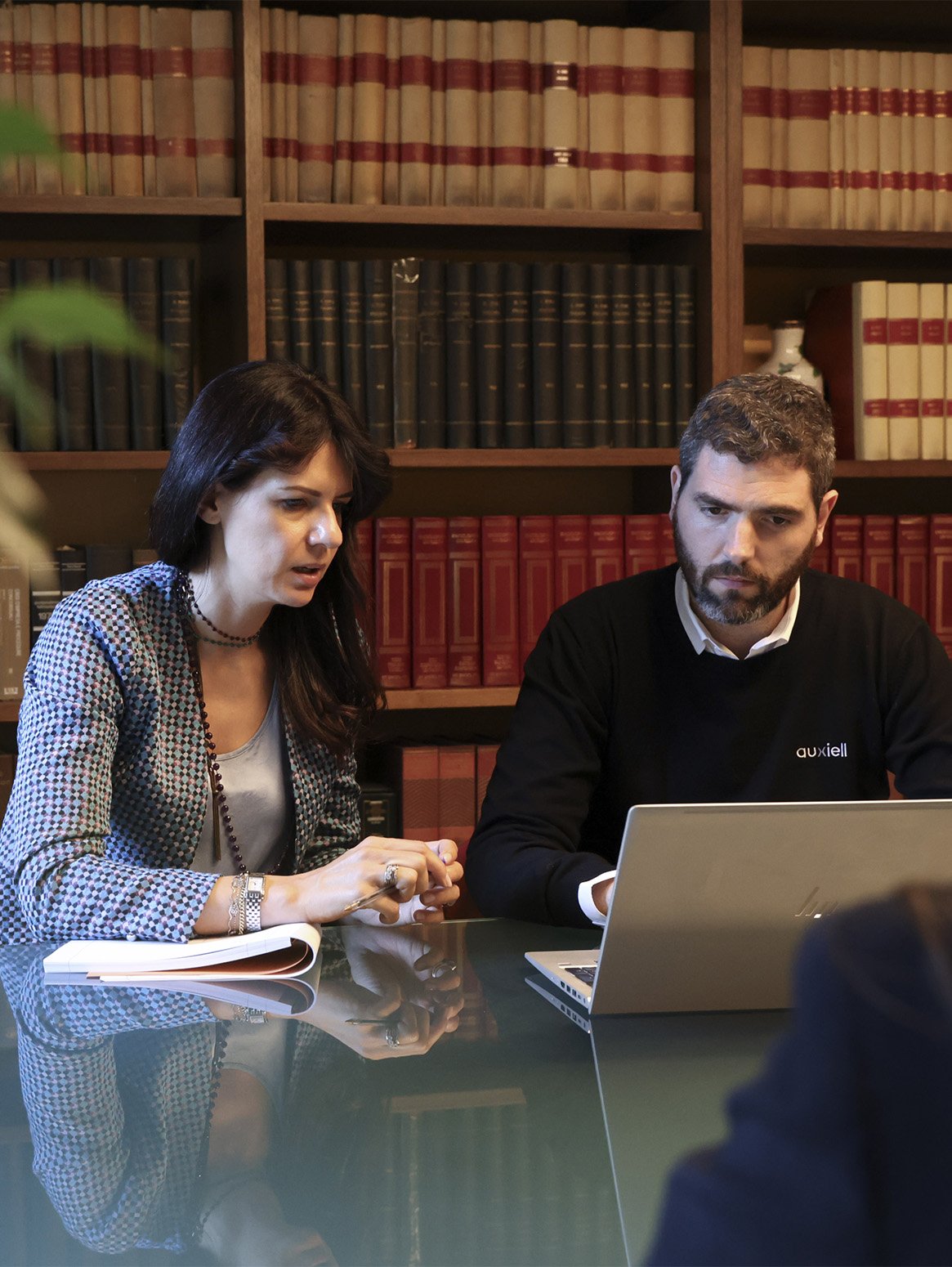
Academy Law Firm's Challenge
Create a structured, measurable, and high-performingprocess for evaluating, valuing, and managing portfolios of bank-originated impaired loans .
The starting point
The transformation of the Delivery macro-process
2024
Year start collaboration
with auxiell

The collaboration continues
With Academy Project, we undertook a project on the Delivery macro-process that includes building a process to effectively manage a new portfolio of non-perfoming bank-originated loans (NPLs, UTPs, and Past Due), with the goal of sizing the necessary resources and making this project effective and compatible with the firm's other activities by building a team that works proactively by objectives and have the ability to perform monitoring, measurements, forecasts, and corrections.
SCAN
Lean Gap Analysis® in Delivery
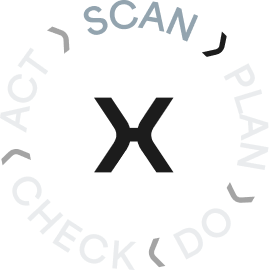
To analyze the current state of the processes, the auxiell-ProjectAcademy team engaged in Lean Gap Analysis®. In this first phase , the team worked to "snapshot" the current state of the entire process of receiving and processing the practice portfolio.
Lean Gap Analysis®
Essential phase to measure and analyze current processes and define gaps between the current and desired state. In this first phase, one goes to "take a picture" of the current state of the processes in terms of quantifying waste, identifying any issues and opportunities for improvement, and timing all steps. Having a clear view of the performance of the process is necessary to identify the most correct countermeasures aimed at removing the root cause of the problem and to design, with a view to the future, the activities to be done-and on which KPIs to measure-to make it efficient.
Absence of process for managing the new practice portfolio
There was initially no standard process that could handle the high volume of practices with well-defined timelines.
Absence of process measurement systems and lack of defined KPIs
There was initially no set of KPIs aimed at measuring the performance of the process for its monitoring.
Assenza di processo per la gestione del nuovo portafoglio pratiche
Non era inizialmente presente un processo standard che potesse gestire l'elevato volume di pratiche con tempistiche ben definite.
Assenza di sistemi di misurazione del processo e mancanza di KPI definiti
Non era inizialmente presente un set di KPI volti a misurare le performance del processo per il suo monitoraggio.
PLAN
Lean RoadMap® in Delivery
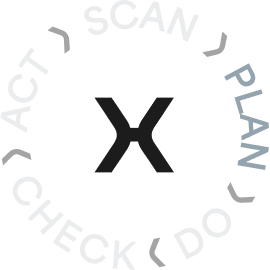
Once the gapsemerged from the Lean Gap Analysis® we moved on to the next phase, namely the PLAN phase. Through the Lean RoadMap® we thus defined the sequence of implementation of the most correct leantechniques that would allow us to achieve the goals agreed upon with the Academy Projectteam. The Lean RoadMap®identifies techniques and methods applied throughout the project.
Lean RoadMap®
Stage in which the future state of the analyzed process is planned from a multi-scenario perspective. Once the most technically and economically correct scenario is chosen, we move on to planning the path to be taken to achieve it. In the Lean RoadMap® emerge the activities to focus on and the timeframe with which to complete them.
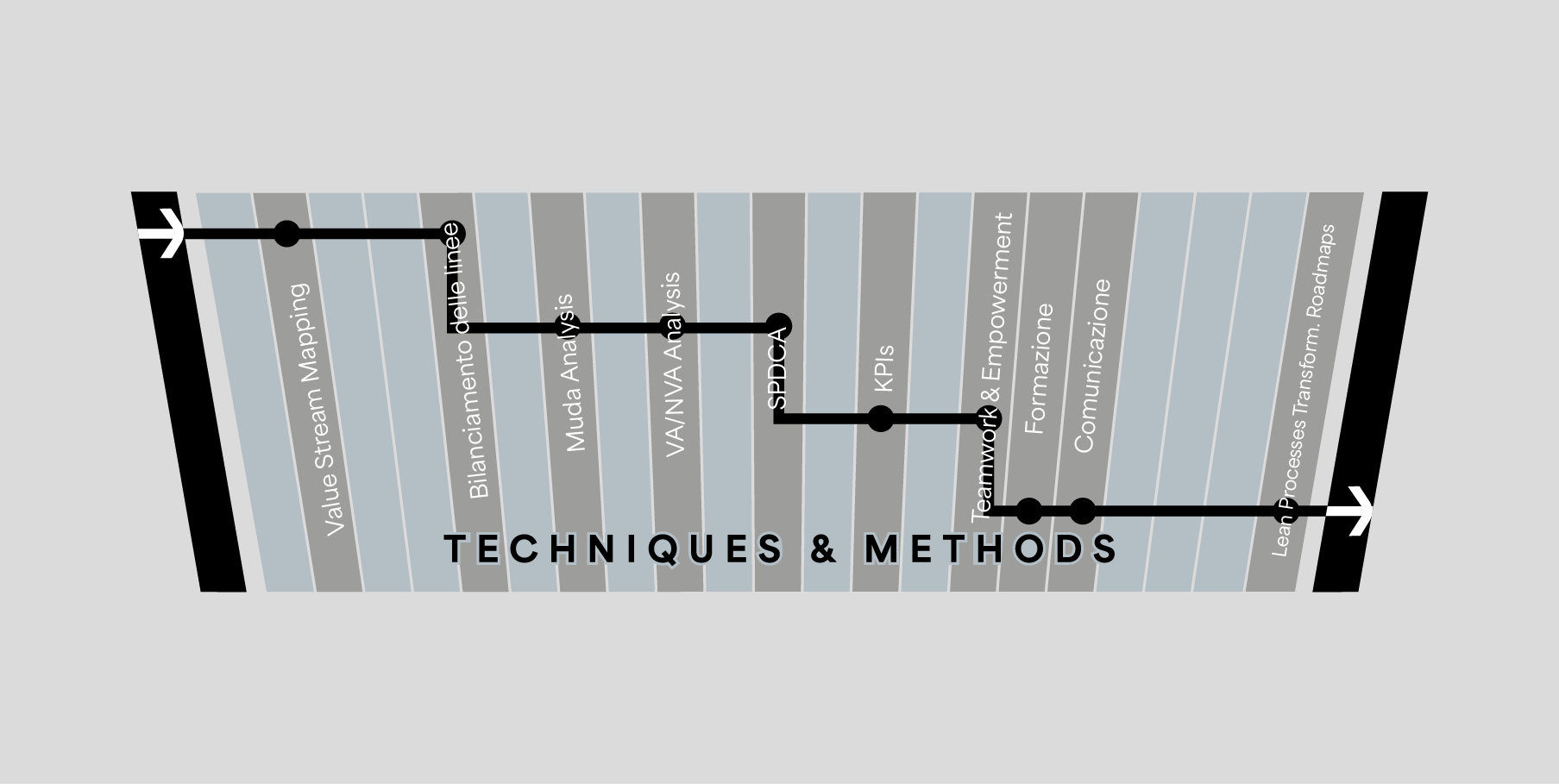
Makigami of the future state of the process
To construct the future state of the process by identifying the activities needed, the relative owner, the time needed to perform them, the information to be able to complete them properly, and the expected output from each.Balancing activities and defining the optimal workflow
To effectively level the workload among various professionals by identifying the correct sequence of activities to be completed and their owners.
Skill matrix
To identify any gaps that need to be filled and figure out which activity to assign to specific resources according to their knowledge and skills.
Activity roadmap construction.
To construct the sequence of activities to be carried out in the target timeframe.
Defining process monitoring KPIs.
With the dual function of monitoring the distribution of files according to the identified macro-activities and checking the number of open and closed activities and their punctuality.
Construction of practice management templates.
To communicate externally uniquely on behalf of the practice and be effective and comprehensive in practice management and response.
Problem solving .
To check--in the light of the defined KPIs--the progress of the process and make relevant decisions and countermeasures if necessary.
Makigami dello stato futuro del processo
Per costruire lo stato futuro del processo individuando le attività necessarie, il relativo owner, il tempo utile per eseguirle, le informazioni per poterle portare a termine correttamente e l'output atteso da ognuna.Bilanciamento delle attività e definizione del workflow ottimale
Per livellare efficacemente il carico di lavoro tra i vari professionisti individuando la corretta sequenza delle attività da portare a termine e i relativi owner.
Skill matrix
Per individuare gli eventuali gap da colmare e capire quale attività assegnare alle specifiche risorse a seconda delle loro conoscenze e competenze.
Costruzione della roadmap delle attività
Per costruire la sequenza di attività da svolgere nelle tempistiche obiettivo.
Definizione KPI di monitoraggio del processo
Con la duplice funzione di monitorare la distribuzione delle pratiche a seconda delle macro-attività individuate e verificare il numero di attività aperte e chiuse e la puntualità delle stesse.
Costruzione dei modelli di gestione delle pratiche
Per comunicare esternamente in maniera univoca a nome dello studio ed essere efficaci ed esaustivi nella gestione e risposta della pratica.
Problem solving
Per verificare - alla luce dei KPI definiti - l'andamento del processo e prendere le relative decisioni e contromisure se necessarie.










Reduced lead time from order to shipment
Riduzione lead time dall'ordine alla spedizione
DO
Delivery Overall Transformation
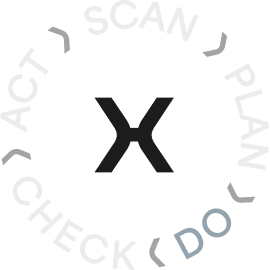
What lean activities and techniques enabled us to achieve the set goal?
Makigami and standardized workflow to balance activities
Starting from the detection of the execution time of individual activities useful for processing the case file, the processing time required to carry out the entire process was reconstructed. Estimating the frequency of occurrence of the various types of files - such as, for example, foreclosures, bankruptcy proceedings and merit litigation - proved necessary to build a model for calculating the number of resources needed to be able to execute the files in the required time. Activities were distributed among the various resources of the team according to their skills with the aim of balancing the workload and eliminating process bottlenecks. The execution of the activities thus shifted from a point in time view of processing the individual file to an overall view of the entire file portfolio and balancing complexity, execution time and due dates.
Skill Matrix
For each resource, the level of knowledge and skill related to the execution of the type of practice in question was mapped in order to identify any gaps to be filled This analysis also allowed us to identify the current-and target-level of the overall skills of the workgroup, as well as being a useful input for balancing, to understand which activities to assign to specific resources depending on individual skills.
Construction of the roadmap of activities
Based on the processmakigami, we then constructed the sequence of activities to be performed and identified the target lead times within which to complete them. At the same time, we also defined the correct and standard wording to be entered into the practice management software so that when the individual practice was opened, it would already be broken down into the individual tasks correctly timed according to the closing date.
Defining KPIs for monitoring the process
With teamleaders , a dashboard of useful indicators was constructed for tracking the timeliness of activities and monitoring the progress of the process in question. Specifically, KPIs such as punctuality (in terms of closed activities and delayed activities), incidence of activity progress by type, punctuality of activities by type of file, and average days of delay were defined. These indicators were chosen because they are useful-when monitored weekly-to understand the progress of the process and take timely countermeasures in case of deviations .
Construction of practice management templates
Standard text templates to be used in practice management have been defined to make the drafting of the text and communication to stakeholders effective and efficient. As a result, the response process is poka-yoke--free of errors--faster and more usable in terms of identifying the info needed to properly complete the file itself.
Problem Solving
The problem solving process has been implemented to ensure the flow of the process: from the analysis of identified KPIs and potential deviations, it is now possible to scientifically identify the root causes of the problem and countermeasures aimed at solving it.
Makigami e workflow standardizzato per bilanciare le attività
Partendo dalla rilevazione dei tempi di esecuzione delle singole attività utili all'elaborazione della pratica è stato ricostruito il processing time necessario allo svolgimento dell'intero processo. La stima della frequenza di accadimento delle varie tipologie di pratiche - quali, per esempio, pignoramenti, procedure concorsuali e contenziosi di merito - si è rivelata necessaria per costruire un modello di calcolo del numero di risorse necessarie per poter eseguire le pratiche nei tempi richiesti. Le attività sono state distribuite tra le varie risorse del team a seconda delle loro competenze con lo scopo di bilanciare il carico di lavoro ed eliminare i colli di bottiglia del processo. L'esecuzione delle attività è passata quindi da una visione puntuale di elaborazione della singola pratica a una visione d'insieme dell'intero portafoglio pratiche e di bilanciamento tra complessità, tempi di esecuzione e date di scadenza.
Skill Matrix
Per ogni risorsa è stato mappato il livello di conoscenza e competenza relativo all'esecuzione della tipologia di pratica in oggetto al fine di individuare gli eventuali gap da colmare Tale analisi ci ha permesso inoltre di individuare il livello attuale - e obiettivo - delle competenze complessive del gruppo di lavoro, oltre a essere un input utile per il bilanciamento, per capire quale attività assegnare alle specifiche risorse a seconda delle skill individuali.
Costruzione della roadmap delle attività
Sulla base del makigami del processo è stata poi costruita la sequenza di attività da svolgere e sono stati individuati i lead time obiettivo entro cui concluderle. Contestualmente abbiamo anche definito la dicitura corretta e standard da inserire nel software di gestione delle pratiche in modo tale che al momento dell'apertura della singola pratica questa risulti già scomposta nei singoli task correttamente tempificati in base alla data di chiusura.
Definizione KPI di monitoraggio del processo
Con i responsabili del team è stato costruito un cruscotto di indicatori utili per la rilevazione delle tempistiche delle attività e il monitoraggio dell'andamento del processo in oggetto. Nello specifico sono stati definiti KPI quali puntualità (in termini di attività chiuse e attività in ritardo), incidenza di avanzamento delle attività per tipologia, puntualità delle attività per tipologia di pratica, giorni di ritardo medio. Questi indicatori sono stati scelti perché utili - se monitorati settimanalmente - a capire l'andamento del processo e prendere tempestivamente le contromisure necessarie nel caso di scostamenti.
Costruzione dei modelli di gestione delle pratiche
Template testuali standard da utilizzare nella gestione della pratica sono stati definiti per rendere efficace ed efficiente la stesura del testo e la comunicazione agli interessati. Il processo di risposta risulta così poka-yoke - privo di errori -, più veloce e fruible in termini di individuazione delle info necessarie a completare correttamente la pratica stessa.
Problem Solving
Il processo di problem solving è stato implementato per garantire lo scorrere del processo: dall'analisi dei KPI individuati e dei potenziali scostamenti è possibile ora individuare con approccio scientifico le cause radice del problema e le contromisure volte a risolverlo.
CHECK
Have we achieved the goals set?
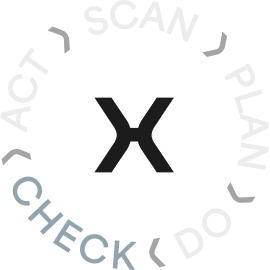
The organization of workloads is significantly improved through the implementation of resource skill mapping techniques and the construction of the standardized task advancement process.
Managers now have complete visibility into the team'sworkload and remaining capacity and can better manage the processing of additional paperwork.
The identified KPIs enable the team to monitor the progress of the process to take timely countermeasures-if necessary.
L'organizzazione dei carichi di lavoro è sensibilmente migliorata grazie all'implementazione delle tecniche di mappatura delle competenze delle risorse e alla costruzione del processo standardizzato di avanzamento dei task.
I responsabili hanno ora completa visibilità sul carico di lavoro del team e sulla capacità residua e possono gestire al meglio l'elaborazione di ulteriori pratiche.
I KPI individuati permettono al team di monitorare l'andamento del processo per prendere tempestivamente contromisure - se necessario.
From Delivery to future opportunities for collaboration
The introduction of the lean approach has made it possible to build a standard, measurable and replicable process, even in a highly complex and highly variable environment such as the management of impaired loans. The new organization now enables Accademia Studio Legale to efficiently manage substantial portfolios, monitor performance, and adapt quickly to change. A structured approach that has transformed an operational challenge into a tangible competitive advantage.
Do you want to improve your company's performance?

Our experts on hand to guide your business to transformation
Sign up for our newsletter and receive exclusive content, practical tips and news straight to your inbox!


